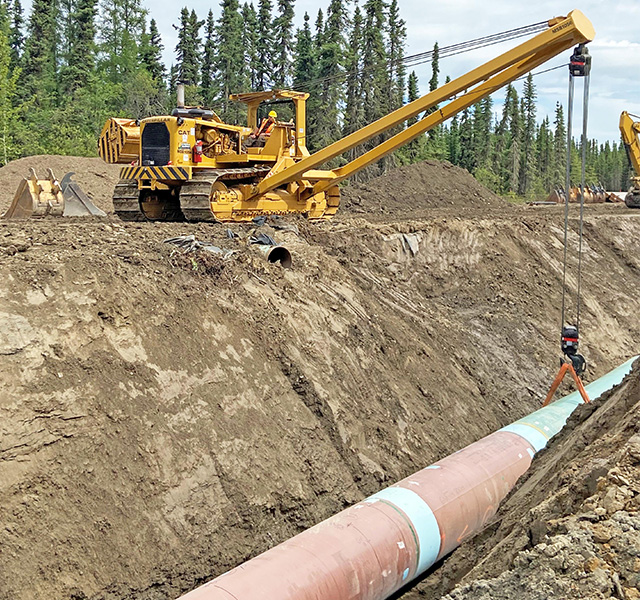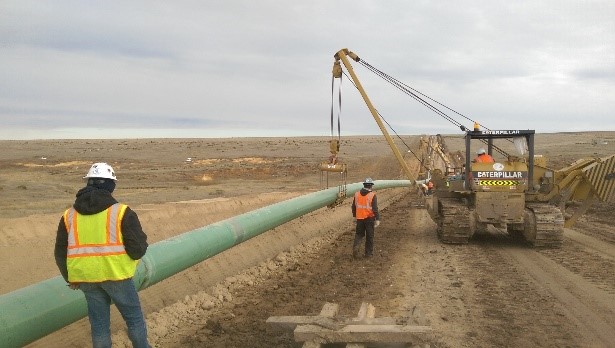Expert Insight of Creek Pipe reviews and Customer Experiences
What You Need To Learn About Pipe Trenching Solutions: A Comprehensive Overview of Available Options
Pipe trenching solutions are vital for the installment and maintenance of below ground utilities. They entail different methods customized to particular needs and settings. Comprehending these methods is vital for reliable job execution. Each alternative provides its own set of advantages and challenges. As the demand for reliable energy administration rises, understanding what to take into consideration when picking a trenching service comes to be critical. What aspects should one focus on to ensure success?
Comprehending Pipe Trenching: What It Is and Why It Issues
Although usually ignored, pipe trenching is a crucial process in numerous building and energy jobs. This method involves excavating narrow trenches to promote the setup of pipelines for water, gas, sewage, and telecoms. The importance of pipe trenching hinges on its duty in making certain that these important systems are properly integrated right into facilities, making it possible for the safe and effective distribution of essential services.Proper trenching is vital for keeping the honesty of pipes and minimizing risks connected with soil erosion and collapses. It additionally enables for effective evaluations and maintenance of underground energies. In addition, recognizing the regional regulations and environmental considerations is important, as incorrect trenching can result in expensive delays and legal issues. Ultimately, pipeline trenching acts as the fundamental action that supports various construction endeavors, making it a significant facet of modern-day facilities advancement.
Common Trenching Methods for Below Ground Energies
In the domain of underground utilities, various trenching methods play a vital role in installation and maintenance - Creek Pipe HDPE installation. The open-cut trenching approach, directional boring technique, and hydro excavation process each offer one-of-a-kind advantages relying on the details job needs. Understanding these methods is necessary for effective and efficient utility management
Open-Cut Trenching Approach
Open-cut trenching is a commonly made use of technique for installing underground utilities, specifically when the depth and size of the trench permit efficient accessibility. This method entails digging deep into a trench along the suggested course of the utility, offering straight visibility and access for installation. It is especially advantageous for jobs that call for comprehensive excavation, as it promotes quick setup and examination. However, it likewise demands careful preparation to decrease interruption to the surrounding location, consisting of web traffic and existing frameworks. Open-cut trenching is most effective in open rooms where the dirt conditions agree with, however it might be limited in metropolitan atmospheres as a result of the presence of existing energies and various other below ground obstacles.
Directional Boring Strategy

Hydro Excavation Refine
Exactly how does hydro excavation attract attention amongst typical trenching methods for underground energies? Hydro excavation uses high-pressure water and vacuum technology to securely eliminate soil, permitting specific excavating around sensitive underground energies. This approach lessens the danger of harmful existing infrastructure compared to traditional mechanical excavation. By using water to loosen up the soil, hydro excavation supplies a less invasive approach, reducing the potential for dirt compaction and ensuring a cleaner worksite. Additionally, the process improves exposure during excavation, boosting general precision and effectiveness. Hydro excavation is particularly advantageous in urban locations where utility lines are largely packed, making it a preferred choice for specialists concentrated on safety and accuracy in below ground tasks.
Benefits of Trenching Services
While various approaches exist for mounting underground energies, trenching services provide unique advantages that make them a preferred choice for numerous jobs. One significant benefit is the cost-effectiveness of trenching, as it generally calls for less specific equipment contrasted to choices like hydro excavation. This usually leads to reduced labor and functional costs. Furthermore, trenching can fit a large range of energy kinds, consisting of water, sewer, and gas lines, offering adaptability for contractors.Moreover, trenching enables efficient access to several lines in a solitary excavation, reducing interruption to the surrounding location. The procedure also allows specific installment and repair, which is vital for sticking to governing criteria and ensuring long-term dependability. Eventually, trenching can be carried out reasonably quickly, decreasing job timelines and permitting for faster solution restoration. These advantages collectively make trenching solutions a functional alternative for many underground energy tasks.
Drawbacks and Difficulties of Trenching
Regardless of the countless advantages of trenching solutions, there are remarkable disadvantages and obstacles that should be considered. One considerable challenge is the capacity for dirt instability, which can lead to collapses, presenting risks to employees and devices. Additionally, trenching can interfere with existing energy lines, demanding cautious preparation and sychronisation to stay clear of service interruptions. The process can likewise be time-consuming, especially in urban locations where space is limited and access is restricted. Additionally, trenching may require extensive permits and governing compliance, including complexity and potential hold-ups to projects. Ecological concerns, such as dirt erosion and damages to local ecosystems, can emerge from incorrect trenching techniques. Lastly, the costs related to trenching, including labor and tools, can escalate if unanticipated problems arise throughout the task, making it crucial for stakeholders to consider these obstacles against the benefits when considering trenching solutions.
Key Variables to Think About When Picking a Trenching Service
Selecting the right trenching solution can substantially affect the success of a task. Several vital elements must be evaluated to ensure a suitable option. The firm's experience and proficiency in trenching procedures are important; a well-established solution with a solid track record is commonly more reputable. Next, reviewing the devices utilized is fundamental, as modern equipment can boost performance and accuracy. In addition, it is considerable to consider the range of solutions used, consisting of excavation deepness and dirt type handling, to confirm they meet certain job requirements.Another element to review is the company's reputation; consumer testimonials and endorsements can supply insights into previous efficiency. Obtaining comprehensive quotes that describe costs and timelines will certainly assist in spending plan monitoring. Validating conformity with neighborhood laws and sector requirements is important for preventing potential legal concerns. By assessing these factors, clients can make an informed choice visit the website when choosing a trenching solution.
Precaution in Pipe Trenching
In pipe trenching, safety and security measures are essential to guaranteeing worker defense and website integrity. Key elements consist of the usage of individual protective equipment, extensive excavation site inspections, and distinct emergency feedback methods. Applying these procedures considerably decreases dangers related to trenching procedures.
Individual Protective Devices
Safety and security in pipeline trenching heavily counts on the appropriate use personal safety tools (PPE) Employees ought to use difficult hats to i thought about this shield against dropping objects, as well as high-visibility vests to enhance their presence on-site. Steel-toed boots are essential for foot security against hefty devices and products. In addition, handwear covers are necessary for hand security, especially when taking care of harsh or sharp things. Respirators might additionally be essential in environments with dust or hazardous fumes. Eye security, such as safety goggles, should be worn to shield against particles. Finally, listening to defense is important in noisy workplace. By sticking to PPE standards, employees can substantially lower the threat of injury and assure a safer trenching procedure.
Excavation Website Evaluation
Correctly evaluating the excavation website is a basic action in ensuring a secure pipe trenching operation. This process includes reviewing the site for potential dangers such as below ground energies, unpredictable soil conditions, and nearby frameworks. A complete analysis enables the identification of threats that might endanger worker safety. In addition, confirming the dirt kind and moisture degrees can assist identify suitable shoring methods to stop trench collapses. It is essential to assure that the site is free from debris which appropriate signage is presented to notify employees of continuous procedures. Routine evaluations throughout the task can likewise aid find any adjustments in website problems, allowing timely modifications to safety actions and work methods.

Emergency Response Protocols
Emergency situation feedback protocols are vital in mitigating dangers related to pipeline trenching operations. These procedures guarantee that all personnel are prepared to act promptly and successfully in emergencies. Crucial element consist of routine safety drills, clear interaction networks, and assigned emergency departures. Additionally, first-aid kits and emergency situation contact numbers need to be easily accessible on-site. Trenching operations must likewise include treatments for taking care of hazardous circumstances, such as cave-ins or utility strikes. Educating employees on acknowledging prospective threats and comprehending their duties throughout an emergency is vital. Maintaining an updated website security plan can greatly enhance feedback performance. On the whole, efficient emergency preparedness cultivates a much safer working environment and lessens the influence of unexpected cases.
Expense Considerations for Trenching Services
Recognizing the monetary implications of trenching solutions is necessary for project preparation and budgeting. The expenses connected with trenching can differ commonly based upon a number of factors, consisting of job dimension, soil kind, and depth of the trench. Labor prices commonly represent a substantial part of the complete cost, as experienced drivers are essential for efficient implementation. Furthermore, tools leasing costs can add to the total budget, specifically for specialized machinery.Site ease of access is an additional essential factor; tough terrain might necessitate extra sources, boosting costs. Permitting and governing compliance can additionally contribute to expenditures, particularly in city locations where policies are stringent.Lastly, unpredicted problems, such as experiencing existing utilities, can cause unexpected prices and delays. Because of this, acquiring thorough quotes from trustworthy trenching company is necessary for accurate budgeting and making sure successful project conclusion.
Often Asked Questions
The length of time Does a Common Pipe Trenching Task Take?
The duration of a normal pipe trenching task differs significantly based upon aspects such as deepness, soil problems, and job complexity. Typically, it can take anywhere from a few days to a number of weeks to complete.
What Devices Is Frequently Utilized in Pipe Trenching?

Are There Environmental Regulations for Trenching Activities?
Environmental laws for trenching tasks commonly need compliance with local, state, and government guidelines. These regulations intend to lessen environmental disruption, protect water resources, and assurance proper waste look at these guys monitoring during excavation and installation procedures.
Can Trenching Providers Be Integrated With Other Building And Construction Tasks?
Trenching services can certainly be integrated with various building and construction jobs. By coordinating initiatives, effectiveness can be achieved, decreasing disturbances while making sure that all required infrastructure job is completed in a prompt and affordable fashion.
What Are Usual Soil Keys In Run Into in Trenching?
Typical soil kinds encountered in trenching consist of clay, sand, silt, and loam. Each type offers distinct challenges, influencing excavation techniques and stability, demanding cautious planning to ensure risk-free and efficient trenching operations.